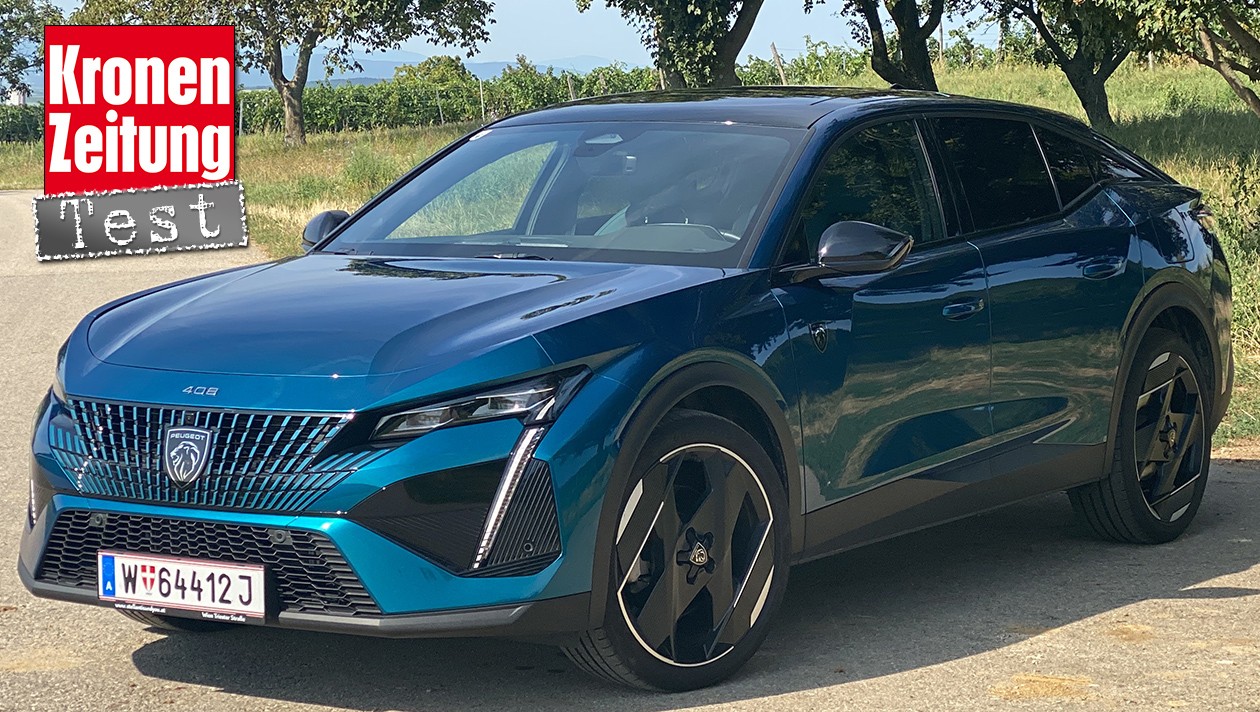With the new 408 series, Peugeot has created a beautiful car that stands out from the 308 and 508, between which they placed the new one. Visually astonishingly independent and blessed with plenty of space, it appeals to emotion and reason in equal measure – but has a confident price. “Krone” engine editor Stephan Schätzl was on the road with the 225 hp plug-in hybrid. His impressions here in the video.
Is the 408 just an expensive 308? Not at all. Sure, the platform and technology come from its brother, but at 4.69 meters it is significantly longer than a 308 hatchback and still noticeably longer than the 308 SW station wagon. But shorter than a 508. So: It fits perfectly into the gap, if you will – and looks the freshest of all. This may also be due to the eye-catching Obsession Blue metallic, which is the only paint color that doesn’t cost any extra. That alone is a special feature, as it often only includes a very simple color that you don’t want. Somehow the 408 doesn’t fit into any vehicle category. Many people call it a crossover, that’s always possible. Peugeot says “dynamic fastback”. We say: hatchback sedan with increased ground clearance (19 centimeters). The plastic paneling actually makes it its own Allroad version. In terms of format, it is the successor to the long-discontinued BMW 3 Series GT. Maybe that’s why the prices are at the BMW 3 Series level. You feel comfortable in the 408, as a driver, front passenger, back seat passenger or piece of luggage. The trunk holds 471 liters (65 liters more for the pure combustion engine); if you fold it over using remote unlocking, it’s 1545 liters. There is space for people up to 1.90 meters tall under the glass roof in the back seat, and there is plenty of knee room thanks to the 2.79 meter wheelbase. The only thing that hurts slightly is your feet when the height-adjustable front seat is fixed in the lowest position. Function Follows Form At the front you are almost surrounded by the dashboard, which flows directly into the door panels. Not really homely, more stylish. That was probably the basic principle – also when it comes to operation. The 10-inch speedometer display has a 3D effect, but is a touch too playful. And the central touchscreen, which is the same size, is a bit confusing. The so-called i-Toggles are cool, i.e. the large touch surfaces underneath that can be assigned functions – like an extension of the touchscreen. Yes, nice, but just as unnecessary as the i-Cockpit with the speedometer unit above the steering wheel. You can handle it, but classic is more pleasant. For i-Toggles & Co this means: Please bring back buttons and dedicated climate control! There is, however, a proper volume control. That’s a good thing.In the peace and quiet with a lot of powerIt’s quiet while driving. Hardly any wind noise, and especially when you’re driving on electric power, you don’t notice anything from the drive. In electric mode, this actually goes up to 50 kilometers if the 12.4 kWh battery was full to begin with. The petrol engine normally stays in the background acoustically, but when accelerating it tends to rev higher than you would like and then sounds a little tortured. If the battery is empty, you can expect to use around seven liters. The tank holds 40 liters of fuel. The drive consists of a 1.6-liter four-cylinder gasoline engine with 180 hp and a 110 hp electric motor that sits in the eight-speed automatic transmission. System output 225 HP, system torque 360 Nm. This enables the vehicle, which weighs 1.7 tons according to DIN, to do a standard sprint in 7.8 seconds and a top speed of 233 km/h. Only the front wheels are driven, which you can sometimes feel in the steering. It is relatively lacking in feel, but reasonably direct, only turns in with a slight delay, but does not return to the center 100%. The driving comfort suffers somewhat from the wooden rolling 20-inch rims, which were mounted instead of the 19-inch wheels that were standard in the top GT trim tested (plus 300 euros). 17-inch wheels are mounted in the base.The pricesThe test car costs a good 60,000 euros, the price list for the powerful hybrid starts at 52,000 euros, and for the GT (including delicacies such as LED matrix etc.) at 55,000 euros. It is also available with a system output of just 180 hp. You save 1500 euros. Or another 2000 euros because it is also available in the basic version. The cheapest Peugeot 408 comes in at 38,000 euros. But you don’t get a plug-in hybrid, just a 1.2 liter 130 hp three-cylinder petrol engine in basic equipment. It weighs 300 kilos less than the hybrid, but is still comparatively sluggish – according to the technical data (10.4 s, 210 km/h), we didn’t drive it.Driving premium prices for a Peugeot? You have to want to invest that. But the Peugeot 408 stands out from the crowd, offers plenty of space and a fresh ambience. If you can charge at home (possible with up to 7.4 kW), usually don’t drive more than 50 kilometers per day and otherwise like to have some power under your belt that you don’t want to use all the time, this is the right place for you. Why ?Sparkling designLots of spaceSpeedy top engine with mediocre rangeWhy not?A plug-in hybrid is always a compromise cockpit and operation takes some getting used toOr maybe……Citroen C5 X, Volvo V60 Cross Country, Skoda Superb Scout, otherwise Peugeot 308 SW or 508
source site-13
